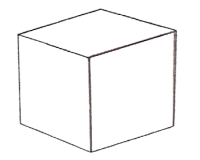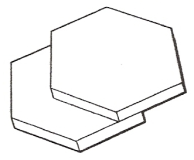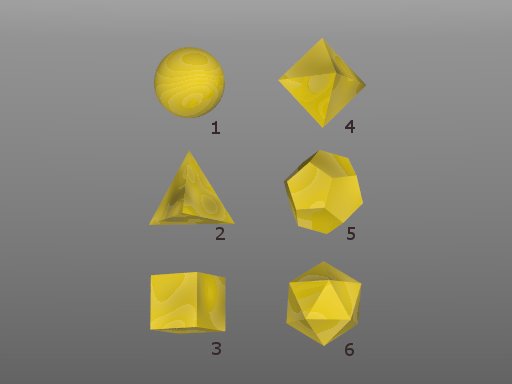Manuscript on Sacred Geometry
To understand the term Sacred Geometry each word must be comprehended in its own meaning and then in combination with the other. Geometry is actually two Latin words meaning Earth (geo) and measurement (meter). These describe the word Geometry as a branch of mathematics which deals with points, lines, surfaces, and solids. Geometry examines measurements between points and their mutual relationships in space.
A system of numbers is used to measure any line between points either on a surface (plane geometry) or around or through a 3 dimensional form (solid geometry). These measurements can then be translated into area and volume respectively.
The word Sacred is more difficult to define as it is dependent on any individual belief system. That which may be regarded with reverence by one group of people may be reviled by another. Philosophers have ever searched to find the commonality of all belief systems and define this in a basic simple context as an underlying truth. Using numbers and alphabets as symbols is one way to condense the Cosmic and Natural Laws into pure forms which in themselves allow a transformation of consciousness in the student. Involution is the decent of spirit into matter for the purpose of using forms to evolve to perfection.
Essential in these studies is to recognize the importance of Planet Earth as a realm in which the building of forms out of matter is possible. This is a world in which abstract symbols including those of numeric value can be manifested in actual physical structures. The most common building materials are stone and clay earth. Architecture is an extension of geometry in function. When a structure is designated as an altar, stone circle, shrine, temple, or monument to be consecrated as holy to a Deity or Power, that place is called Sacred.

Frequently such structures are situated to take advantage of clear field of vision to effectively maximize observation of celestial changes and cycles. Most often these sacred places are built over pre-existing power centers of Earth Energy. Points on lines of power all over the planet have been plotted and used for ages of time by religious and secular leaders to enhance productivity and prosperity through connection with the Planet Earth in specific ways. The remnants of buildings and monuments created by ancient cultures around the world validate the concept that peoples worldwide shared the awareness of the Earth as filled with power and as a reflection of the cosmos. Hence we have the connection between the sacredness of Earth and Cosmos, and a system of measurement used together to express reverence for existing forces in the human planetary existence = Sacred Geometry.
Pythagoras lived in the 6th century B.C. and is considered the Father of Western Sciences. The priestess oracle at the Temple of Delphi predicted he would be a great man. He was born on the Greek Isle of Samos and from an early age had the privilege to study and travel throughout the known world which included India, Egypt, Persia, and also studied the Hebrew mysteries.
He compiled information from all these cultures and formed a school in Greece which taught the philosophy named Pythagoreanism. The main tenets of this philosophy were the transmigration (reincarnation) of the soul, and the belief in numbers as the ultimate elements of the universe. He taught that One God was the Supreme Mind activating the universe and that all the sidereal bodies were alive. The Pythagorean Tetractys is the model he used as to him it revealed the Mystery of Universal Nature.

He is most revered for his teachings in music, astronomy, and geometry. The diatonic scale in music; and that the pitch of musical tone is directly related to the length of the string was developed by Pythagoras. This relationship is a constant principle in all forms of wave motion including light and radio waves. These ratios reflect a common periodic pattern in nature. He described shapes of the elements as polyhedrons (a solid figure with more than six plane surfaces) inspired by the mineral crystal formations found on Earth.

The four most common kinds of crystal groups or systems are illustrated below showing the forms of one mineral from each group.

FeS3
System

ZrSiO4
Hexagonal (six sided) System

Be3Al2Si6O18

Al2O(SiO4)

CaSO4·2H2O
Cleavage is the tendency of some minerals to break into definite planes producing smooth surfaces. A mineral may cleave in only one direction like mica, or two like feldspar, or in several directions like halite (common salt).

H2KAl3(SiO4)3

KAlSi3O8

PbS

CaCO3

CaF2

ZnS
A protégé of Pythagoras named Plato, based his concept of the Dodecahedron as the form of the Deity employed in tracing the Plan of the Universe, on this basic teaching. He also formulated the Five Platonic Solids as symbolizing the essential universal shapes from which all forms are created. He held the doctrine that perfect objects of perception are real in that they participate in an independent realm of immutable essences and ideas or logical forms which constitute the world of essential reality.

Aristotle, a pupil of Plato, was noted for developing Metaphysics as a philosophy which deals with the First Principles and seeks to explain the nature of being or reality and origin of the structure of the world. Metaphysic translated literally means 'that beyond the physical' or a science of incorporeal truths as the foundation for physical existence and form in matter.
In the present, these studies are relevant to the student of philosophy, archeology, history, astronomy, geology, and chemistry. The fields of medicine, biology, and physics are all based on these simple designs found in nature through combinations of minerals and elements (see Manuscript on Chemical Elements). Geometry in lifeforms can be used as a foundation for both symmetrical and asymmetrical growth patterns. A simple example is the five petalled rose based on the shape of an even sided pentagram. In more complex formation, the evolved rose expresses layer upon layer of five petals, each spiraling out to more beautiful flowering.

Because the human body has a torso surrounded by five appendages including the head, the Rose is considered a symbol of the Human being in a metaphysical context. In itself, the form of the human body is made up of many elements each with crystalline structures reflective of the chemical components existing on the planet. Many philosophers and scientists have extrapolated on these wonders of life and spirit down through the ages. The Human Being is an extraordinary creation in the universe which is given form here on this planet Earth.

The concept that the physical world can not be separated from the spiritual has been with human beings from the very beginning of time. Throughout the ages, sages, mystics, teachers, and philosophers have continued to pass down this fundamental truth. That which is essential constitutes the intrinsic nature of something of most excellent or perfect form; a model existing in the mind as an ideal. Geometry and symbolism are the means whereby all spiritual facts are expressed and by a knowledge of which they are interpreted. The absolute, complete, perfect form of matter is described by Sacred Geometry.
Manuscript on Sacred Geometry is an excerpt from the Metempyrion manuscripts on The Metaphysical Dimensions of Physical Forms. 1956-76 C.E.